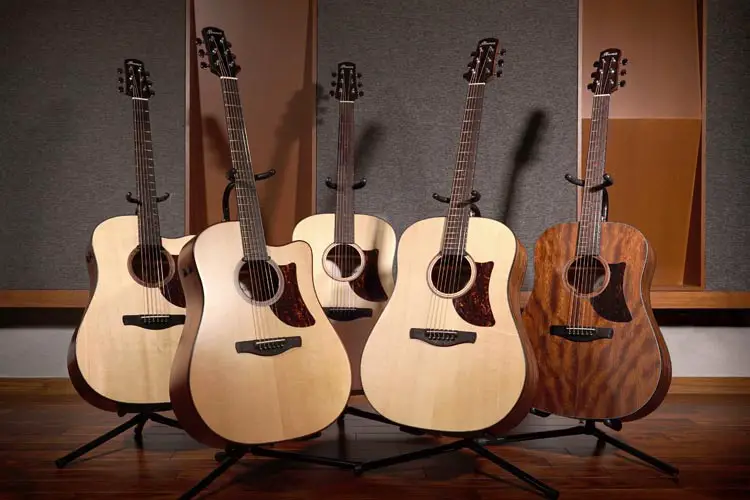Is the guitar body one of the many factors that determine its tone? And if yes, how? Throughout my guitar playing career, I have frequently wondered this question.
So I started looking around, reading a few of my guitar books, watching videos, and searching the internet. I did discover the solutions. I’ll give you a fast answer first, and then we’ll explore further.
It’s safe to say that the guitar body does impact tone because it provides the resonance that determines the tone of the instrument – regardless of acoustic or electric guitar. When playing acoustic guitars, it controls note volume, and when playing electric guitars, it controls note sustain.
By reading this article, you will have a better understanding of how guitar body characteristics, including thickness, wood, size, shape, and weight, can affect a guitar’s tone.
Also Read: 4 Factors That Affect Guitar Intonation: Tips For Best Tone
How Does Guitar Body Affect Tone?
| Guitar Body Part | Impact To Tone |
| Thickness | Thicker guitars tend to have a fuller tone with improved sustain. |
| Wood | The type of wood used can either sharpen or dull the volume and richness of a guitar’s tone. |
| Size | The smaller the body size of a guitar, the more treble response and brightness of sound the instrument will have. |
| Shape | Sound waves bounce differently inside differently shaped guitars. |
| Weight | Sound doesn’t resonate well in heavy or super thick weighted guitars |
1. Thickness
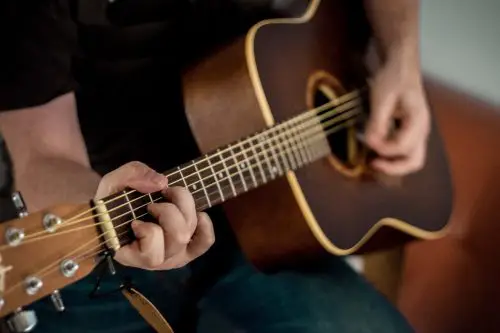
Heavier guitar are difficult for beginners whereas for new players thinner guitar have great and better playing profile
Thicker and heavier guitars have fuller tone and better sustain but can be more difficult to play.
The body thickness of the majority of ordinary acoustic guitars is about 4 inches. Due to its thickness, the guitar can generate a rich, full tone while still being playable.
People claim that the overall tone of a guitar is not significantly impacted by the thickness of the body.
They support this claim by pointing out that while having the same neck and pickups as the Les Paul, the SG guitar lacks the bass and sustain of the latter.
In actuality, body thickness is a crucial consideration when choosing a guitar even if it has little impact on the sound.
2. Wood
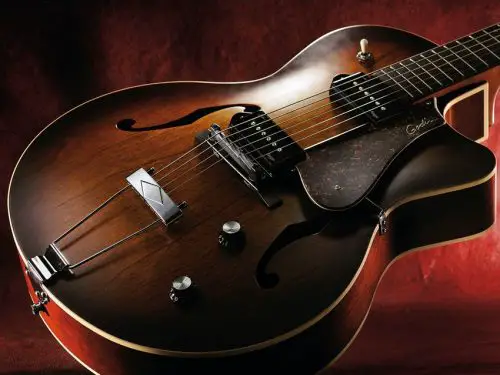
Both acoustic and electric guitar’s tone are influenced by the type of wood
The quality of the wood can enhance or detract from the volume and richness. In actuality, the body wood type has a greater impact on tone than the neck and fretboard wood types.
Acoustic and electric guitars’ tones are influenced by the type of wood used in their construction, but acoustic guitars are more affected.
Denser woods produce more sustain and a crisper tone because vibrations from the soundboard are amplified and reflected more forcefully into the interior. Softwoods dampen the sound by absorbing some vibrations.
This means that waves will bounce off of the soundboard strongly if the body material is harder. The sound is brighter and tighter as a result.
The use of softer wood has the opposite effect. The tone is more mellow and kind. A dull sound will result from extremely soft wood.
3. Size
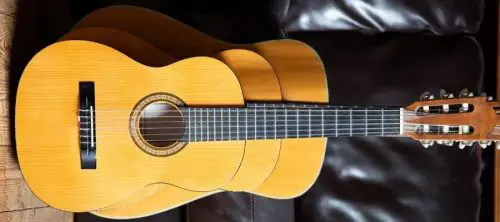
A tone is mostly affected by the size of guitar
A guitar’s tone is affected by size. A smaller body will give the instrument greater treble response and brightness, while a larger body will increase the potential for bass response.
Additionally, most people anticipate that bigger guitars will sound rather “big,” whereas they anticipate that smaller guitars will sound more subdued.
It’s interesting how the guitar with the smaller body size can produce some disproportionately and unexpectedly loud volumes. Additionally, the range of bass and treble frequencies is typically much more evenly distributed in smaller body types.
This becomes much more crucial if you’re thinking about playing live with an acoustic guitar. A smaller guitar will be able to handle feedback much better during live performance without the extra bass and “goofiness” of the larger body, and when you consider that in a studio setting it’s much easier to add bass than to remove it, you can safely assume that a smaller guitar will most likely give you a cleaner recording over a larger one.
4. Shape
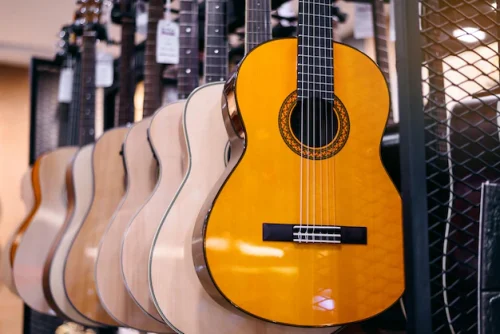
It is because sound waves bounce differently so the shape of a guitar is more important
Because sound waves bounce differently inside various guitar shapes, the shape of a guitar is important.
The guitar’s shape also has an impact on how resonant the tone is, how it feels and sounds, how it looks, and how easy it is to access the frets. This is how;
Acoustic guitar strings vibrate and produce sound waves as you play them. Through the sound hole, the guitar’s body, and the instrument as a whole, sound and vibration travel.
You may find a pretty wide variety of acoustic guitars with distinctive tones by changing the body shape. A hollow-body guitar has a form that resembles an hourglass or a figure eight.
The waist is a common term for the body’s narrowest area. The position and width of the waist change how the vibrations move within the guitar.
The internal braces that hold the guitar in place can also affect how the instrument sounds. So the shape does affect how it sounds, but only indirectly.
If you were to take two pieces of wood that were the same shape and weight, but one was a Strat-style body shape and the other a Flying-V shape, there wouldn’t be a noticeable difference in the sound.
So it’s important to know that it’s about the thickness and weight of the wood, rather than the shape of the design.
5. Weight
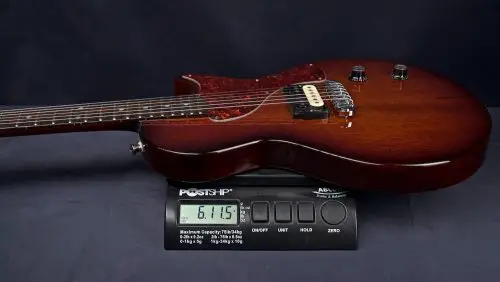
The weight of the guitar plays an important role in sounds
The weight of the guitar affects how it plays and sounds. When playing electric guitar unplugged, the weight can have a very slight effect on tone because vibration must go through a greater mass.
But with acoustic guitars, weight is more important. Acoustic guitars are often lightweight so that they can produce better sound. How?
The sound would be destroyed if the wood was thick and the acoustic guitar was extremely heavy. It wouldn’t resonate as effectively in the body.
You can tell the difference between an acoustic guitar soundboard and a thick kitchen table by giving them each a knock.
The soundboard has a better resonance. Thus, acoustic guitars are quite light and the wood is not particularly thick. So, when shopping for an acoustic, test different sizes, shapes, and weights out.
In conclusion, I suggest that if you’re shopping for an electric guitar, the strings, pickups, and kind of pickups (single coils, humbuckers, or a mix of both) are the most crucial factors to consider in terms of tone.
However, to get the greatest tone out of your acoustic instrument, you need to pay attention to the guitar’s body material, body form, weight, size, and thickness.
Also Read: 5 Factors Of Good Guitar Neck: Ft.Wood Material, Radius, Cost
Best Guitar Body Wood For Great Tone
The best guitar body wood for great tone is available to us in abundance. A few of them are Alder, Maple, Ash, etc.
1. Alder
Body woods made of alder often have a balanced tone. Although relatively solid and light in weight, the wood nonetheless has a good texture. This keeps the music from getting dull while allowing it to reverberate and produce sustain.
Also Read: Ash Vs Alder Body: Which Is Better For Weight, Tone & Price
2. Maple
Guitars with maple bodies are renowned for producing piercing, bright tones. Due to its extreme density and weight, this species of wood tends to generate a brilliant tone that favors higher frequencies. It can emphasize notes more strongly than with less dense body wood because of this.
3. Ash
Ashwood comes in two primary varieties: hard and soft (aka swamp ash). The extra pores and holes in the softer form look fantastic. This is what gives it a scooped sound with a heavier treble accent.
Hard ash has more sustain since it is much denser. Generally speaking, strong ash is preferable for heavy rock and metal, whereas soft ash works well for blues, jazz, and light rock.
FAQs
Q: How Much Does the Guitar Body Affect Tone?
There are three primary components of a guitar that might affect the tone. The body, fretboard, and neck comprise them. The body is arguably the most significant of the three, followed by the fretboard and the neck.
Acoustic or electric guitars’ tones are shaped by resonance, which is provided by the guitar body, making it the instrument’s most crucial component.
It determines the volume of notes when playing acoustic guitars, and the sustain of notes when playing electric guitars.
Q: How Thick Should a Guitar Body Be?
The majority of guitar bodies are about 2-3 inches thick. Some are thicker than others, but a decent general rule of thumb is 2-3 inches. However, the thickness of guitar bodies depending on the type can still range from 4.1 to 104.8 millimeters (mm).
The ideal thickness for contemporary guitars depends on the kind of wood that was used in their production.
While certain woods may need as much as 3.3 mm, softer woods perform better at 2.8 mm. Steel strings must be 3.17 mm or larger.
While a Stratocaster’s typical thickness is 1.77 inches (45 millimeters). However, minimum thickness generally depends on the components.
That said, Since it varies on the brand and model of the guitar, there is no clear-cut response to this question.
Q: Does Wood Affect Electric Guitar Sound?
Wood does affect the sound of electric guitar – especially the guitar neck. Different types of wood have unique characteristics that dictate how sound vibrations are carried from the string to the pickups.
For instance, due to its well-balanced tone, alder is a highly popular wood for electric guitar bodies. It features a satisfying ratio of low-end and high-end frequencies, giving it a rich sound that is ideal for a wide range of genres.
Q: Does Fretboard Wood Affect Tone Electric Guitar?
Similar to how the neck wood affects tone, the wood of the fretboard also has an impact on the sound of electric and acoustic guitars. What matters most is how dense the timber is. The tone will be brighter and have less sustain if the wood is denser.
For instance, manufacturers choose Ebony wood for fretboards because it is a distinctive option. Smooth and hefty, it offers you a brighter tone and is perfect for playing fast riffs.
Even more so than when it is used as a body wood, maple wood is frequently employed by them for fretboards. It is renowned for creating a bright tone with great clarity and is quite hefty and dense.
The most popular choice for fretboard wood, on the other hand, is undoubtedly rosewood. This is due to the well-balanced wood’s ability to give your guitar a warm, smooth tone.


